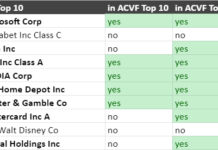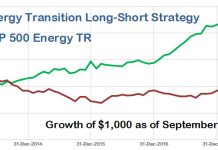UPDATE 3/4/2011: An up-to date article on selecting green mutual funds and ETFs can be found here.
Mutual funds are often touted as an inexpensive way to achieve diversification. With declining brokerage commissions, this is often no longer true. If you are interested in investing in alternative energy, is a mutual fund or ETF right for you?
Here are the currently available mutual funds and ETFs of which I’m aware with alternative energy type themes:
| Fund Name | Emphasis | Mgmt Style | Load? |
| Turnover | |||
| Ticker | Expense Ratio | ||
| Guinness Atkinson Alternative Energy | Alternative Energy & Energy technology; International | Active | No-load |
| 22% | |||
| GAAEX | 1.98% | ||
| New Alternatives Fund | Renewable Energy & environment | Active | 4.75% under $25K |
| 40% | |||
| NALFX | 1.25% | ||
| Powershares Cleantech Portfolio | CleanTech | Index | ETF |
| low* | |||
| PZD | 0.70% | ||
| Powershares Wilderhill Clean Energy | Greener and Renewable Energy | Index | ETF |
| 6% | |||
| PBW | 0.71% | ||
| Powershares Wilderhill Progressive Energy Portfolio | Nuclear and Advanced Fossil Fuels | Index | ETF |
| low* | |||
| PUW | 0.70% |
* These funds are too new to have published turnover ratios, but I anticipate that they will have low turnover (<10% annual) because they are index funds.
Diversification reduces the company-specific risk of a portfolio, but leaves market and sector risk. Most of these benefits can be captured with a 30 stock portfolio, with greater benefit accruing to investors who make a conscious effort to choose dissimilar companies. So to determine if a mutual fund, ETF, or stock portfolio is the most cost-efficient way to achieve diversification I will compare the costs across portfolio sizes and time horizons.
The following chart shows the amount of money you will have after the given time period, assuming that the underlying stocks return 10% per year, and dividends are reinvested (which can be accomplished commission-free via DRIPs in a stock or ETF portfolio.) The 10% return is simply a guesstimate included for demonstration purposes and is in no way to intended to be an actual prediction of returns. There is never any guarantee of future results.
Values in bold indicate the best investment option (given these assumptions) for any time period/initial investment combination.
| Initial Investment | 1 year | 3 years | 5 years | 10 years |
| $1,000 in GAAEX (only available for IRAs) | $1082 | $1266 | $1463 | $2119 |
| $1,000 in NALFX | N/A | N/A | N/A | N/A |
| $1,000 in Powershares | $1076 | $1282 | $1536 | $2397 |
| $1,000 in 30 stocks | $605 | $732 | $886 | $1427 |
| $2,500 in GAAEX (only available for IRAs) | $2700 | $3151 | $3677 | $5407 |
| $2,500 in NALFX | $2590 | $3063 | $3622 | $5509 |
| $2,500 in Powershares | $2716 | $3245 | $3876 | $6047 |
| $2,500 in 30 stocks | $2255 | $2729 | $3301 | $5317 |
| $5,000 in Powershares | $5449 | $6509 | $7776 | $12,130 |
| $5,000 in 30 stocks | $5005 | $6056 | $7328 | $11,801 |
| $10,000 in Powershares | $10,914 | $13,038 | $15,576 | $24,297 |
| $10,000 in 30 stocks | $10,505 | $12,711 | $15,380 | $24,770 |
| $20,000 in Powershares | $21,843 | $26,095 | $31,175 | $48,630 |
| $20,000 in 30 stocks | $21,505 | $26,021 | $31,486 | $50,707 |
An examination of the chart reveals that, at the minimum investments ($2,500 for non-retirement accounts) for NALFX and GAAEX, it is always cheaper to buy one of the Powershares ETFs for a $15 brokerage commission than to pay the high expense ratios and possible load for the traditional mutual funds. Even the $1000 minimum for retirement accounts allowed by the GAAEX is only a bargain for holding periods less than three years, after which the nearly 2% expense ratio eats too much into the gains.
This demonstrates the well known advantages of using low-cost index funds (in this case index-ETFs) over traditional mutual funds, but as we move to accounts in the tens of thousands of dollars with longer holding periods, even the low 0.7% expense ratios of the Powershares ETFs start adding up, and paying $15 a trade to buy a portfolio of 30 stocks begins to look better. If you consider that $15 a trade is fairly costly for most online discount brokers these days, and many offer free trades for qualifying accounts.
This leads to the question, if your alternative energy portfolio is in the sweet spot to use the Powershares ETFs, which one(s) should you choose? The answer will depend mainly on what motivates you to invest in Alternative Energy in the first place. If you’re most interested in Global Warming, you will gravitate towards PBW. PUW caters to investors concerned about energy security, and PZD companies focus most strongly on traditional environmental issues such as pollution. For a $3000+ portfolio, the extra commissions involved in splitting your portfolio between two or three will not have a significant impact on your returns. Or you could buy one, and when then buy a different one when you have more money to invest.
Finally, if you have $20,000 or more to invest, and and can leave it there for a few years, what stocks should you choose? If you don’t have time to educate yourself about alternative energy stocks, the simplest way to go about it is look at the holdings of the mutual funds or ETFs you would have bought, if they were not too expensive. PBW, PZD, and PUW have lists of holdings that are particularly easy to use. It may strike you as strange, to buy a basket of stocks with so little research into the actual companies, but that is exactly what you are doing when you buy any index fund… this technique just lowers the fees if your account is the right size.
Caveats
I have ignored some oft-cited advantages of mutual funds in this analysis, most importantly the ability to make small, regular investments for dollar cost averaging. I consider this more a matter of self-discipline than good investment strategy. The point of dollar cost averaging is to discipline ourselves into buying more of a fund when it is relatively inexpensive, and less when it is more expensive (even when we don’t really know what expensive or inexpensive is.) Nevertheless, if automatic payments are the only way to force yourself to invest, you can always set up automatic payments into a money market mutual fund, and whenever that fund reaches some fixed amount over something like $1000, you can invest the money in an ETF, or add a stock to your portfolio. These investments can be used to maintain a balanced portfolio by always investing in underperforming sectors.
None of the investment options I have discussed are truly diversified portfolios; a diversified portfolio will contain investments in a broad range of industries and asset classes. For most investors, alternative energy should account for only a fraction of the entire portfolio. If investment in alternative energy is taken as part of a broadly diversified overall portfolio, there is less need to own as many individual stocks for diversification, so long as no one stock comprises more than 2-4% of the entire portfolio. This makes the individual stock method of investing more attractive, as it will require relatively fewer transactions.
Finally, when investing in a taxable account, owning individual stocks or low turnover ETFs allows the investor to tax-manage the account more effectively.
Shiller on Mutual Funds
In summary, I’ll leave the last word to Robert J. Shiller, who noted in his prescient book Irrational Exuberance [p.202],
It is often said that people have learned about the importance of portfolio diversification and are using mutual funds to acheive this. Given well-managed funds with low management fees, this argument makes some sense. But many funds charge such high fees that investors might be better off trying to achieve diversification themselves, if diversification is the primary investment motive. Moreover, when they are investing outside of a tax-free environment, by holding stocks directly investors can avoid capital gains taxes on the gains the mutual fund managers realize when they sell stocks in the funds’ portfolios, an important issue with higher turnover funds. Investors can instead realize, for tax purposes, the losses on the stocks that go down. Mutual funds clearly have their limitations.
DISCLOSURE: Tom Konrad and his clients do not have positions in any of the securities mentioned here, although they do have positions in many of the stocks owned by these funds.
DISCLAIMER: The information and trades provided here are for informational purposes only and are not a solicitation to buy or sell any of these securities. Investing involves substantial risk and you should evaluate your own risk levels before you make any investment. Past results are not an indication of future performance. Please take the time to read the full disclaimer here.
< /body>








